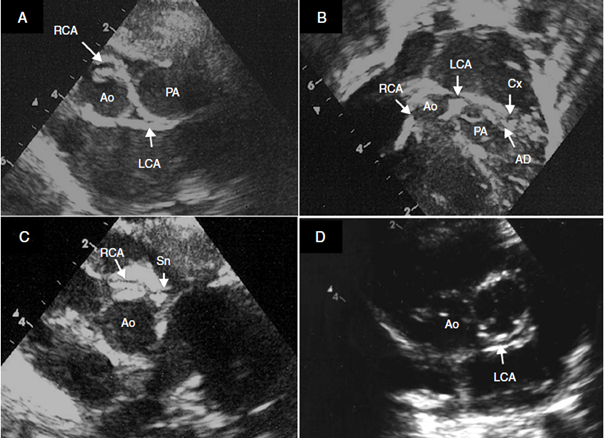Extensive anatomic variability of the coronary arteries in hearts with transposition of great arteries has been described. Usual coronary pattern is defined as right coronary artery arising from posterior facing sinus and left coronary artery from anterior facing sinus. Results of prior case series have suggested that certain coronary patterns are associated with adverse outcomes in surgery (arterial switch operation).
We present the case of a neonate with prenatal diagnosis of transposition of great arteries. Postnatal transthoracic echocardiography showed great arteries in a side-by-side relationship (fig. 1). Coronary pattern was described as inverted or with double coronary looping, which represents less than 3% of the anatomical variants. The entire left coronary artery system arose from the posterior-facing sinus, whereas the right coronary artery arose from the aorta anteriorly. Left coronary artery pursued a retropulmonary course, dividing posteriorly into the circumflex and anterior descending arteries (fig. 2). The patient underwent arterial switch operation uneventfully.

Figure 1 Transthoracic echocardiography, (A) subcostal, (B) apical and (C) short-axis view, showing great arteries in a side-by-side relationship. Ao: aorta; PA: pulmonary artery; LPA: left pulmonary artery; RPA: right pulmonary artery.

Figure 2 Transthoracic echocardiography, (A, C, D) short-axis view and (B) modified apical view, showing coronary arteries origin. Double coronary looping in association with two separate ostia, where left coronary artery arises from the posterior-facing sinus, whereas the right coronary artery arises from the aorta anteriorly. A retropulmonary course of left pulmonary artery can be noticed, dividing posteriorly into the circumflex and anterior descending arteries. We can also appreciate the first branch from the RCA, probably the sinus node artery, which typically arises as the first vessel. Ao: aorta; PA: pulmonary artery; LCA: left coronary artery; RCA: right coronary artery; Cx: circumflex artery; AD: anterior descending artery; Sn: sinus node artery.
Multiple variations in the origin and epicardial course of the coronary arteries have been described in transposition of great arteries patients. Improvements in preoperative imaging and increased operator experience have likely played a role in the trend toward decreased mortality associated with anomalous coronary patterns over time. Special attention should be paid when evaluating the coronary arteries, obtaining great information with a transthoracic echocardiography which can improve surgical results.














